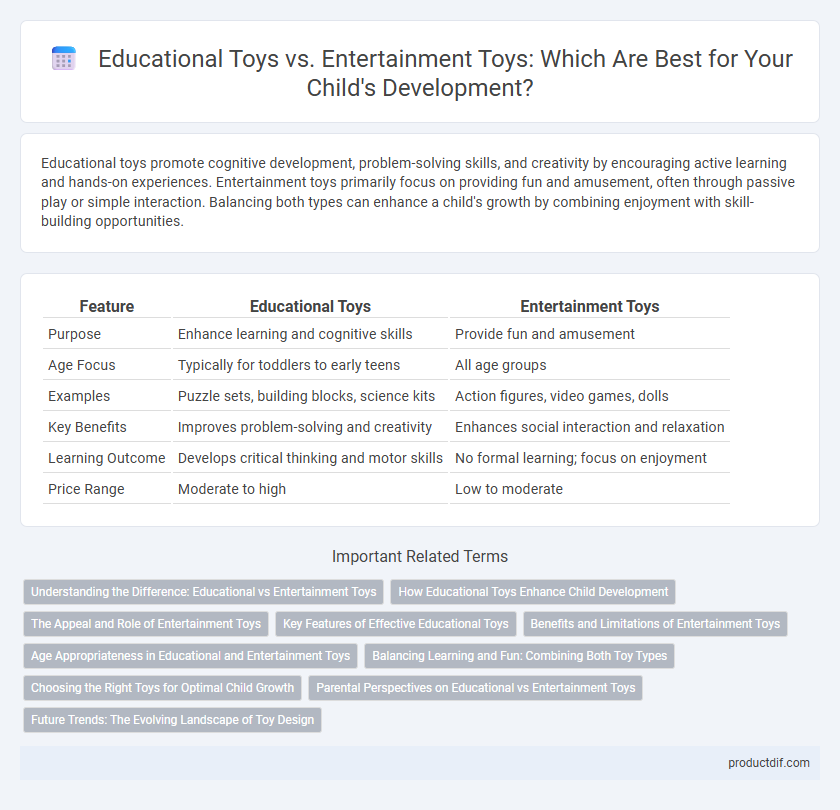Educational toys promote cognitive development, problem-solving skills, and creativity by encouraging active learning and hands-on experiences. Entertainment toys primarily focus on providing fun and amusement, often through passive play or simple interaction. Balancing both types can enhance a child's growth by combining enjoyment with skill-building opportunities.
Table of Comparison
| Feature | Educational Toys | Entertainment Toys |
|---|---|---|
| Purpose | Enhance learning and cognitive skills | Provide fun and amusement |
| Age Focus | Typically for toddlers to early teens | All age groups |
| Examples | Puzzle sets, building blocks, science kits | Action figures, video games, dolls |
| Key Benefits | Improves problem-solving and creativity | Enhances social interaction and relaxation |
| Learning Outcome | Develops critical thinking and motor skills | No formal learning; focus on enjoyment |
| Price Range | Moderate to high | Low to moderate |
Understanding the Difference: Educational vs Entertainment Toys
Educational toys promote cognitive development, problem-solving skills, and creativity by engaging children in activities that require critical thinking and learning, such as puzzles, building blocks, and science kits. Entertainment toys primarily focus on fun and recreation, offering immediate gratification through interactive play, such as action figures, video games, and remote-controlled vehicles. Understanding the difference between these toy types helps parents and educators choose products that balance enjoyment with developmental benefits for children.
How Educational Toys Enhance Child Development
Educational toys promote cognitive skills by engaging children in problem-solving, critical thinking, and creativity. These toys often incorporate elements of math, language, and science, fostering early learning and developmental milestones. In contrast to entertainment toys, educational toys provide meaningful interactions that support long-term intellectual growth and social-emotional development.
The Appeal and Role of Entertainment Toys
Entertainment toys captivate children with vibrant colors, interactive features, and engaging sounds that stimulate creativity and imagination. These toys often incorporate technology, such as electronic games and action figures, enhancing sensory experiences and encouraging social play. Their primary role is to provide immediate enjoyment while subtly fostering problem-solving skills and hand-eye coordination.
Key Features of Effective Educational Toys
Effective educational toys prioritize interactive learning, promoting cognitive development through problem-solving and creativity. They integrate age-appropriate challenges and multisensory engagement to enhance memory retention and fine motor skills. Unlike entertainment toys, they are designed with clear learning objectives, fostering critical thinking and foundational STEM concepts.
Benefits and Limitations of Entertainment Toys
Entertainment toys primarily offer instant amusement and sensory stimulation, enhancing creativity and relaxation through interactive play. However, they often lack structured learning components, which may limit their capacity to develop critical thinking, problem-solving, and cognitive skills compared to educational toys. Prolonged use of entertainment toys can sometimes reduce attention span and promote passive engagement rather than active learning.
Age Appropriateness in Educational and Entertainment Toys
Educational toys are designed to align with specific developmental stages, enhancing cognitive, motor, and social skills appropriate for each age group. Entertainment toys prioritize fun and engagement but may not always support age-appropriate learning milestones. Choosing toys based on age appropriateness ensures balanced growth, combining enjoyment with educational value.
Balancing Learning and Fun: Combining Both Toy Types
Educational toys such as puzzles and building blocks promote cognitive development and problem-solving skills, while entertainment toys like action figures and video games provide imaginative play and relaxation. Combining both types allows children to engage in enjoyable activities that also enhance learning, fostering creativity and critical thinking simultaneously. Balancing educational and entertainment toys supports well-rounded development and sustained interest during playtime.
Choosing the Right Toys for Optimal Child Growth
Educational toys stimulate cognitive development, enhance problem-solving skills, and promote creativity by engaging children in interactive learning experiences. Entertainment toys primarily offer amusement and sensory stimulation, which can support relaxation and social interaction but often lack long-term developmental benefits. Selecting toys that balance educational value with fun ensures optimal child growth by fostering both intellectual and emotional development.
Parental Perspectives on Educational vs Entertainment Toys
Parents often prioritize educational toys for their ability to foster cognitive development, problem-solving skills, and creativity in children, viewing them as valuable tools for long-term learning. Entertainment toys, while appreciated for providing immediate fun and engagement, are frequently seen by parents as less beneficial to developmental growth. Surveys indicate that 68% of parents prefer educational toys because they perceive a direct link to academic success and skill-building.
Future Trends: The Evolving Landscape of Toy Design
Educational toys increasingly integrate augmented reality and AI to enhance interactive learning experiences, shaping future trends in toy design. Entertainment toys are evolving with smart technology and personalized content to maintain engagement and foster creativity. Emerging market data predicts a growing consumer demand for hybrid toys that blend education with entertainment, driving innovation in the toy industry.
Educational toys vs entertainment toys Infographic

 productdif.com
productdif.com